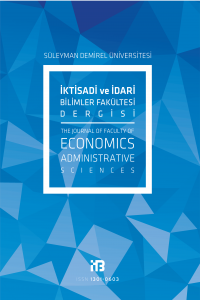MUHASEBE DİLİNDE ÇEVİRİ SORUNLARI
Muhasebenin işlevinin verileri kaydetmek, sınıflandırmak ve özetlemekten ibaret olmadığı, karar alma sürecinin önemli bir birleşeni olan muhasebenin karar alımını etkileyen tüm faktörleri ortaya koyması gerektiği günümüzde anlaşılmış ve bu yönde özellikle Davranışsal Muhasebe alt disiplini altında önemli çalışmalar yapılmıştır. Muhasebenin karşılıklı etkileşim halinde olduğu disiplinlerden biri de dilbilimdir. Muhasebe biliminin gelişimi ve evrensel bir muhasebe dili oluşturulması adına, muhasebe ve dil ilişkisi muhasebe alanındaki profesyoneller ve akademisyenlerce araştırma konusu yapılmalıdır. Bu çalışmada muhasebe ve dil arasındaki ilişkinin ortaya konabilmesi için ilk bölümde bir dil olarak muhasebe ele alınmış, ikinci bölümde ise muhasebe terimlerinin ve finansal raporların çeviri sorunları ortaya konmaya çalışılmıştır. Muhasebenin de yapay bir dil olarak kabul görebileceği varsayımından hareketle, muhasebe terimlerinin açıklanmasında dilbilimsel yöntemlerden yararlanılmıştır. Muhasebe ve dil ilişkisinin açık bir şekilde anlaşılabilmesi için hem günlük hem de seçilmiş terimler verilmeye çalışılmıştır.
Anahtar Kelimeler:
Muhasebe, Kültür, Davranışsal Muhasebe
PROBLEM OF ACCOUNTING TRANSLATION IN ACCOUNTING LANGUAGE
It is now understood that the function of the accounting is not merely to record, classify and summarize the data, and that the accounting, which is an important component of the decision- making process, should reveal all the factors that influence decision making, which led to significant studies under the sub-discipline of Behavioral Accounting. One of the disciplines in which accounting is in interaction is linguistics. For the further development of accounting science and for the creation of a universal accounting language, the relation between accounting and linguistics should be put under research by accounting professionals and academics. In this study, first chapter examines accounting as a language, while second chapter discussing translation problems of the accounting terms and financial reports. Based on the assumption that accounting can also be regarded as an artificial language, linguistic methods have been used to explain accounting terms. In order to clearly understand the relationship between accounting and language, examples from both daily life and selected accounting terms were given.
Keywords:
Accounting, Culture, Behavioral Accounting,
___
- AERTS, W. (1994). On the use of accounting logic as an explanatory category in narrative accounting disclosures. Accounting Organizations and Society, 19(4-5), s. 337-353.
- AVERY, H. G. (1953). Accounting as a language. The Accounting Review, 28(1), s. 83-87.
- BELKAOUI, A. (1980). The interprofessional linguistic communication of accounting concepts: An experiment in sociolinguistics. Journal of Accounting Research, 18(2), s. 362-374.
- BELKAOUI, A. (1990). Judgement in International Accounting. New York: Quourm Boks.
- DE SAUSSURE, F. (1916). Genel Dilbilim Dersleri. (Türkçeye Çev. Vardar, B., İstanbul: Multilingual).
- EVANS, L. (2004). Language, translation and the problem of international accounting communication. Accounting, Auditing & Accountability Journal, 17(2), s. 210-248.
- GÖKTÜRK, A. (1994). Çeviri: Dillerin Dili. İstanbul: Yapı Kredi Yayınları.
- HERBULOT, F. (2004). La théorie interprétative ou théorie du sens: point de vue d'une praticienne. Meta: Journal des Traducteurs, 49(2), s. 307-315.
- JACOP, R. A., & Madu, C. N. (2004). Are we approaching a universal accounting language in five years? Foresight, 6(6), s. 356-363.
- JAIN, T. N. (1973). Alternative methods of accounting snd decision making: A psycho-linguistial analysis. The Accounting Review, 48(1), s. 95-104.
- KAY, P., & Kempton, W. (1984). What is the Sapir-Whorf Hypothesis? American Anthropologist, 86(1), s. 65-79.
- KILLIAN, S. (2010). "No accounting for these people": Shell in Ireland and accounting language. Critical Perspectives on Accounting, 21(8), s. 711-723.
- KOLLER, W. (1979). Einführung in die Übersetzungswissenschaft. Heidelberg: Quelle und Mayer.
- LAVOIE, D. (1987). The accounting of interpretations and the interpretation of accounts: The communicative function of "the language of business". Accounting, Organizations and Society, 12(6), s. 579-604.
- LEDERER, M. (1994). La Traduction Aujourd'hui. Paris: Hahette-Livre.
- MOUNIN, G. (1976). Les Problèmes Théoriques de la Traduction. Paris: Gallimard.
- SAEED, A., & Salah, O. (2012). Development of sukuk: Pragmatic and idealist approaches to sukuk structures. M. Ariff, M. Iqbal, & S. Mohamad içinde, The Islamic Debt Market for Sukuk Securities: The Theory and Practice of Profit-Sharing Investment (s. 42-66). Cheltenham: Edward Elgar Publishing.
- USUL, H. (2007). Davranışsal Muhasebe (1. b.). Ankara: Asil Yayın.
- UYGUR, N. (1997). Dilin Gücü. İstanbul: Yapı Kredi Yayınları.
- VINAY, J.-P., & Darbelnet, J. (1966). Stylistique comparée de l’anglais et du français. Paris: Didier.
- www.investopedia.com. Ocak 29, 2018 tarihinde https://www.investopedia.com/terms/a/armslength.asp adresinden alındı
- www.tdk.gov.tr. Ocak 29, 2018 tarihinde http://www.tdk.gov.tr/index.php?option=com_gts&arama=gts&guid=TDK.GTS.5a709804ced027.51615665 adresinden alındı
- www.tureng.com. Ocak 29, 2018 tarihinde http://tureng.com/tr/turkce-ingilizce/arm's%20length adresinden alındı
- ISSN: 1301-0603
- Yayın Aralığı: Yılda 3 Sayı
- Başlangıç: 1996
- Yayıncı: Süleyman Demirel Üniversitesi
Sayıdaki Diğer Makaleler
BİLGİ EKONOMİSİ VE BÜYÜME ARASINDAKİ İLİŞKİ: TÜRKİYE ÖRNEĞİ
KİMLİK İNŞASINA İLİŞKİN TEMEL YAKLAŞIMLAR VE BU YAKLAŞIMLARIN TÜRKİYE’YE YANSIMALARI
THE COMMON/UNIQUE AND COGNITIVE/CONATIVE MODEL OF DESTINATION IMAGE: THE CASE OF AZERBAIJAN
Murat ÇUHADAR, Satı KÖSEOĞLU, Önder GÜLTEPE
KENT YOKSULLUĞUNUN KENTSEL DÖNÜŞÜM ÜZERİNDEN OKUNMASI
KURT LEWİN’İN LİDERLİK TARZLARI İLE ÖRGÜTSEL SAPMA İLİŞKİSİNİN İNCELENMESİ
